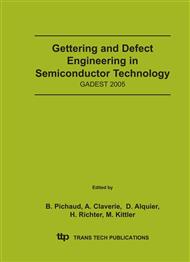p.125
p.133
p.139
p.145
p.151
p.157
p.163
p.169
p.175
Impact of Low Temperature Hydrogenation on Recombination Activity of Dislocations in Silicon
Abstract:
Silicon samples doped with gallium and intentionally contaminated with iron have been studied by means of electron beam current (EBIC), capacitance voltage (CV) and deep level transient spectroscopy (DLTS) methods. Reverse bias anneal (RBA) treatments at temperatures of 390-420K were used to move hydrogen and dissolved iron atoms away from the surface. A new procedure was developed to find dislocations lying on desirable depth from the surface and to analyze the depth distribution of their recombination contrast. Iron contaminated dislocations do not noticeably change their recombination activity when kept in an electrical field as high as 104 V/cm at 420K for several hours. This implies a tight binding of iron atoms at dislocations. The binding energy of iron with dislocations seems to be much larger than for Fe-Ga and H-Ga pairs. Low temperature hydrogenation of iron contaminated dislocations does not produce any passivation effect. In opposite, the recombination activity of the dislocations significantly increases after RBA treatment.
Info:
Periodical:
Pages:
151-156
Citation:
Online since:
December 2005
Authors:
Keywords:
Price:
Сopyright:
© 2005 Trans Tech Publications Ltd. All Rights Reserved
Share:
Citation:


